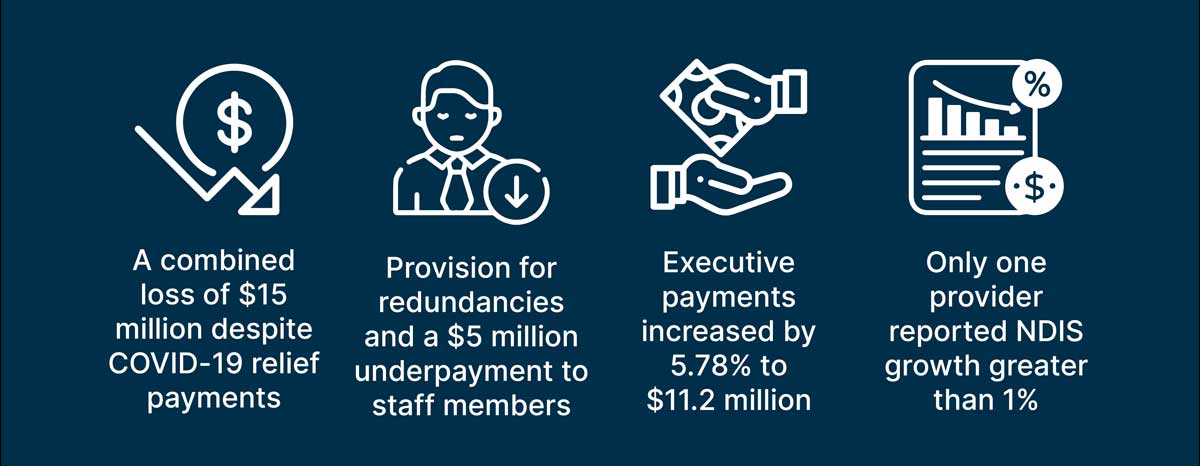- Want to get in touch?
December 5, 2022

It’s annual report season, and some worrying early indicators suggest that 2022 was a terrible year for providers. Our data set indicates that providers have experienced significant losses, business reduction, and consistent restructuring.
In the meantime, executive salaries have increased, which isn’t a great look for our sector, especially considering we are part way through a Royal Commission in addition to an impending review into the NDIS. This article explores how bad it is, what went wrong, and what we can do about it.

For this article, we created a composite of three NDIS providers who account for $1.5 billion in revenue, including $948 million in NDIS revenue. These large players are an essential barometer of the health of the NDIS provider space.
The three providers reported a combined loss of $15 million, with only one posting a minuscule 0.78% margin. These results are a far cry from the exorbitant profits we’ve seen in the media recently.
Worse still, one of these providers reported a -35% return on net assets (RoNA), which is a worrying indicator that there are not too many years like this left in the tank.
Only one of these major providers reported NDIS growth greater than 1%, lending more evidence to a continuing theme that customers prefer smaller providers. Indeed, losing significant sums (which we assume the business invested in clients) and posting limited growth suggests something is profoundly wrong with the customer value proposition.
We were troubled by provisions in the financials for substantial redundancies (100 staff) in one organisation, and a $5 million underpayment in another. This concerning data coincides with combined executive payments of $11.2 million, reflecting a 5.78% increase from prior periods.
Indeed, $6.2 million was accounted for by just 17 executives (an inflated estimate of executives, given turnover). Careful readers of annual reports will notice a strong negative correlation between executive compensation and organisational results.
These providers reported combined profits of ~$40 million this time last year. The prior figure reflected substantial job keeper payments, but this year includes significant COVID-19 relief payments. In fact, without COVID-19 relief payments, one provider would have made a $27 million loss for a RoNA of -65%, which is absolutely disastrous.
Clearly, many providers faced severe COVID-19 disruptions, which have had tremendous operating effects. As a result, many of these providers are now making substantial reductions to their staff in an attempt to address their operational positions.
These trends have deep seeded causes that reach back into the scheme’s inception and beyond. For example, in many organisations we see an undifferentiated multi-service offer across broad geographies. Concurrently, large acquisitions further complicated organisational cultures by integrating multiple management structures, including former government departments.
This situation necessitates an explosion of middle management to attempt to maintain a consistent culture. Occasionally, we see the emergence of “mini departments” in these organisations that can make it challenging to adapt to the fast pace and thin margins of the NDIS. We believe that this round of annual reporting, coupled with news of large restructures, signals a potentially seismic shift in these organisations.
Many of the affected providers have significant Supported Independent Living (SIL) vacancies and inefficient overhead structures that limit their viability. A careful review of their annual report indicates that they haven’t discovered a reportable source of excellent client outcomes, so inefficiency, vacancies, and roster leakages likely explain most of these shortfalls. Some of these providers are undertaking large-scale restructures to address runaway costs; only time will tell if they have gone far enough.
You may recall the DSA administration matter. A detailed reading reveals that their affairs went south quickly, with a fair work matter and revenue reductions becoming insurmountable.
We urge Boards and executives to get an in-depth handle on their site operating metrics and overhead distribution mechanisms:
The DSA administration demonstrated that no organisation is too big to fail. As a result, many organisations have developed viable structures that enable them to post healthy margins and respond rapidly to changes in the NDIS.
The latter will be crucial as we approach the outcome of the Royal Commission and independent review into the NDIS. In the event of a major insolvency, providers will likely line up to accept new customers. For us, this result is devastating as it disrupts the crucial relationships formed between people with a disability and those who support them.
Empathia Group provide expertise in evaluating the performance of NDIS organisations, including benchmarking back-office expenses and processes. If this article has resonated with you, please book a call or reach out to our team to discuss.
Share this article:
Join an exclusive community of providers receiving our eNewsletter Empathia Insider. Get first access to NDIS business insights, free provider resources, and special offers direct to your inbox.

Empathia Group is a collective of business consultants focused on creating sustainable, long-term success for NDIS service providers.
Appointments outside of standard business hours available by request
Empathia Group Pty Ltd © 2022. All rights reserved.